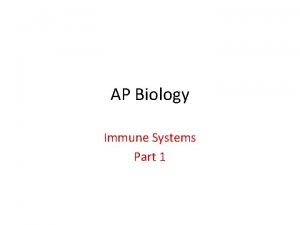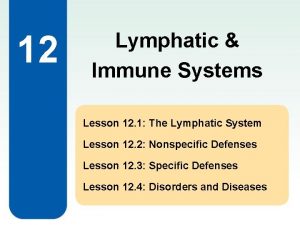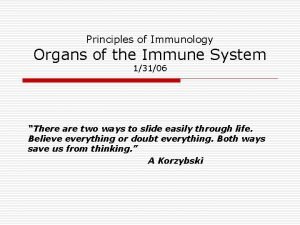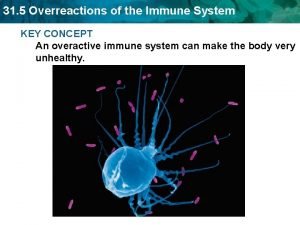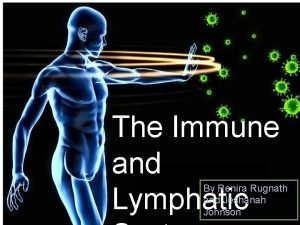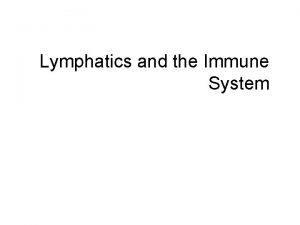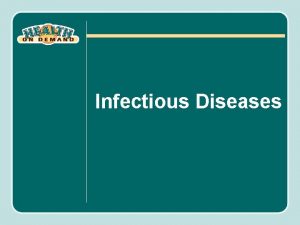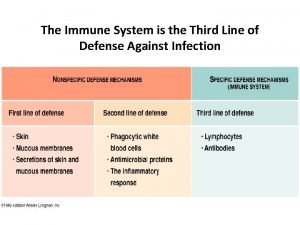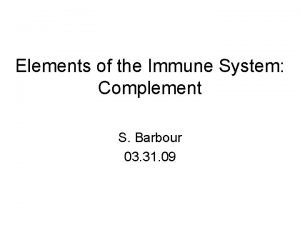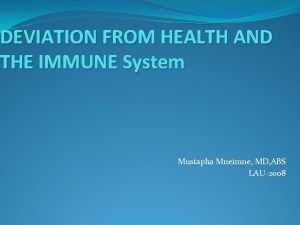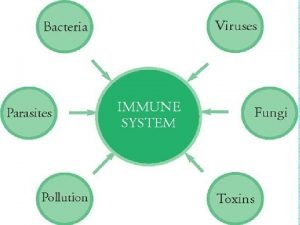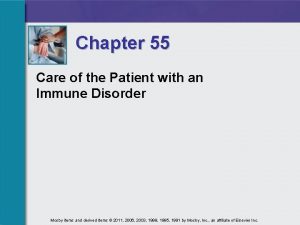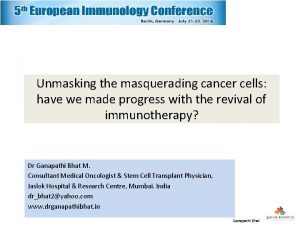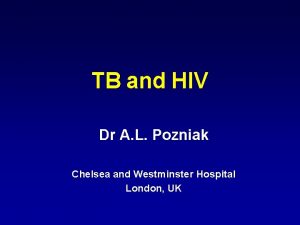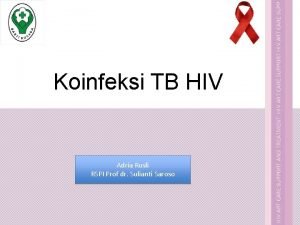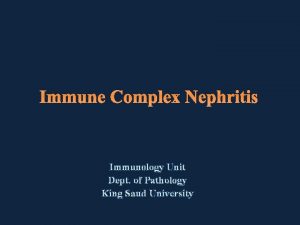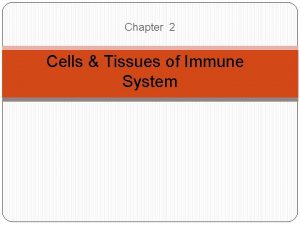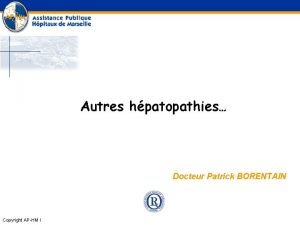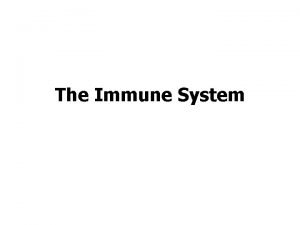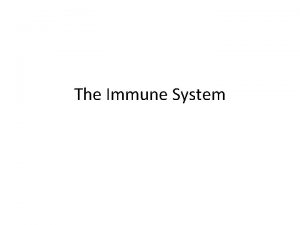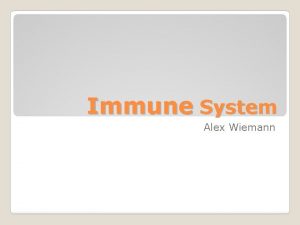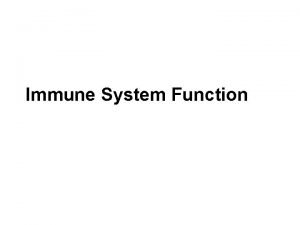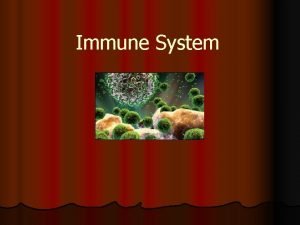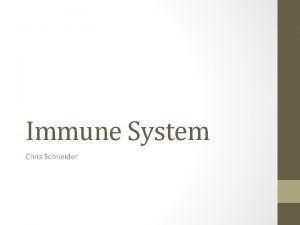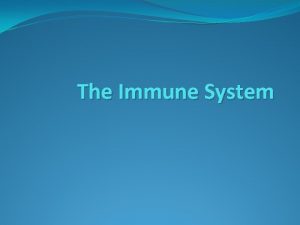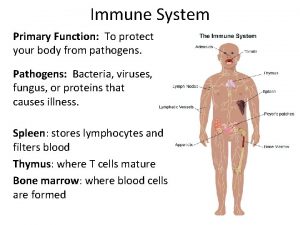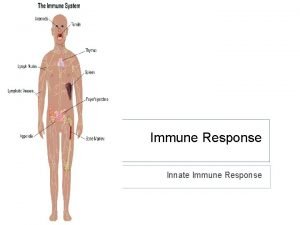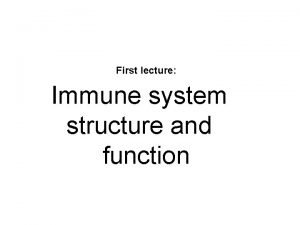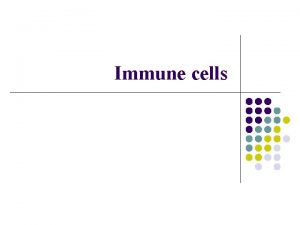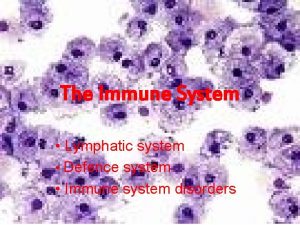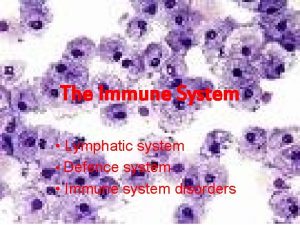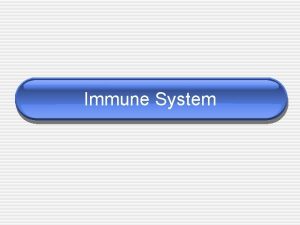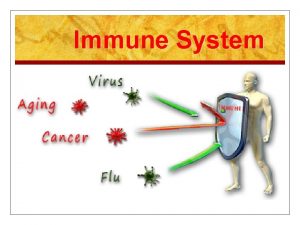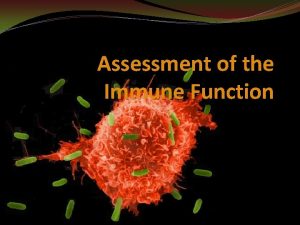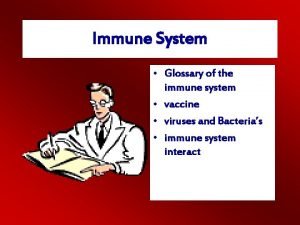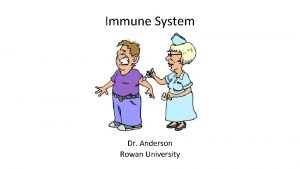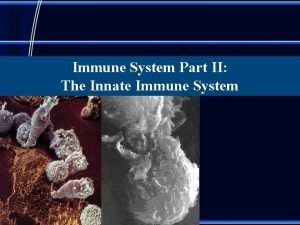Immune System MincerScully Immune System Function To protect




































- Slides: 36

Immune System Mincer/Scully

Immune System Function: To protect and defend the body against invasion by pathogens. n No major organ, there a few that help out: n Spleen n Thymus n Bone Marrow n

Pathogen: A biological agent that causes disease in its host. n Virus n Bacteria n Fungus n Protist n

Disease n Disease-Any disruption of homeostasis which causes specific symptoms, and can cause death if untreated or the immune system is unable to fight it off. n E. g. infection by pathogen, genetic disorder

Germ Theory People used to think that evil spirits or demons caused disease. n Pasteur’s investigation led to theory that many diseases are caused by biological agents, like bacteria. n This is called the Germ Theory of Disease n n Infectious diseases are caused by biological agents

Infectious Agents-Virus n Virus- strand of DNA or RNA wrapped in a protein coating. n Invade a cell (or inject their nucleic acid into a cell) and then cause the cell to make more viruses rather than the cell’s normal function.

Bacteria- Prokaryotic cells n Mostly harmless, but some can live and thrive (and cause disease) inside the body n Sometimes can be cured by antibiotics n n Superbugs have arisen due to overuse of antibiotics (accidental artificial selection)

Superbugs n So-called superbugs are bacteria that have evolved a resistance to most antibiotics. n MRSA (Methicillin-resistant Staphylococcus aureus) is an example. S. aureus is typically found on your skin and can cause pimples. But, if you become infected with MRSA, then it may be life-threatening.

How Do Superbugs Develop Resistance? n Its simple, really: n In any population, some bacteria may have the genes that make them immune to the effects of the antibiotics. If antibiotics are used, the bacteria that aren’t immune die, leaving behind ONLY the ones that have those genes. Therefore, all their offspring will have those genes, and therefore be immune.

Superbugs-Resistance is Futile Only a few bacteria (red) have the gene that give resistance to the antibiotic. The others (blue) don’t. The bacteria that survive now all have the genetic resistance. Those bacteria then reproduce, and all of their offspring have the resistance too.

Fungi-very few members of the Fungi kingdom can parasitize humans n The ones that can tend to attack the skin, but a few can invade inside the body. n

Protists are eukaryotic and microscopic organisms that cause disease n Examples: n Malaria n African Sleeping Sickness n Giardia n

How Do Diseases Spread? n Physical contact Skin to skin contact n Exchange of bodily fluids n n Indirect contact n n E. g. sneezing and coughing Vectors

Vector n A vector is the method by which a pathogen is transmitted to humans. It might NOT be what actually causes the illness n E. g. A mosquito bites your arm, and the protist Plasmodium is transmitted into your bloodstream or a tick bites you and a Borrielia bacteria is transferred and you have Lyme disease n

Prevention of Disease Good hygiene n WASH YOUR HANDS n COVER YOUR MOUTH AND NOSE n

Treatments n Antibiotics-Drugs which kill or weaken bacteria Don’t work on viral infections, like colds n E. g. Penicillin, streptomycin, sulfonamides n

Treatments Rest n Fluids (like orange juice) n Balanced diet n Check with a doctor n

Immune System Function: To protect and defend the body against pathogens n Made of a few smaller organs and white blood cells n

Lymph is extracellular fluid that white blood cells can travel through. n Spleen is an organ that filters bacteria and broken cells from the lymph n Lymph nodes are also filters n

How does the Immune System Work? There are two ways in which the immune system operates: n Nonspecific defenses- Tries to keep everything out n n n Skin, mucus, cilia, tears, stomach acid, etc. Specific Defenses- Fights off infection once the pathogen gets inside the body. n White Blood Cells (WBC’s)

Immune Response If the pathogen gets inside anyway, there are things your body usually does to try to slow the invader down. n Fever- raising body temperature to help denature the pathogen’s proteins n Expand blood vessels- WBC’s can get to the infection site more quickly n n This is called inflammation, and can be painful

Allergies An allergy is a condition where the body misrecognizes something that is harmless as a pathogen n Histamines are the chemicals released to cause the inflammatory response n n n Example: Pollen cause a fever, runny nose, and sneezing Some allergies can trigger a severe reaction, called anaphylactic shock n This can cause choking due to a constricted airway

Allergens

White Blood Cells White blood cells are the soldiers of the body n They seek out and destroy pathogens n Have several different names: WBC’s, Lymphocytes, Leukocytes, Phagocytes n

White Blood Cell Types n T Cells These are the recon cells. n They travel through the body in search of pathogens n When they find a pathogen, they engulf it and destroy it, then they do something weird n They display parts of the pathogen on their membranes n

Antigens The part of the pathogen that the T Cells display is called the antigen n Antigens are proteins that all cells have on their membranes n The shape of the antigen varies according to the species of pathogen n Sometimes, the pathogen itself is referred to as an antigen n

Then… The T Cells show the antigen to the other type of WBC: n B Cells- These cells search their memories. If the B cells have seen this antigen before, they get to work mass producing antibodies n If the B cells haven’t, they start to build antibodies from scratch n

Antibodies n Antibody- a protein molecule which attaches to the antigen on a pathogen and then either: 1. The antibody causes the pathogen to be unable to enter any more body cells n 2. The antibody attracts a WBC to engulf the pathogen n

Immunity is the condition your body has when it already knows how to make the antibodies for a specific disease. n This is why if you get sick with an illness and fight it off (without drugs) you can’t get the same illness again n n When your T Cells show your B Cells a pathogen that has been seen before; the B Cells immediately start making the correct antibodies

Immunity n Two types of immunity Active: Your body knows how to make the antibodies n Passive: You receive antibodies from another source, but your body doesn’t know how to make them n n Mother’s milk n Injection of antibodies

Active Immunity n There are two ways to get active immunity: 1. Get infected with the illness and fight it off —your body learns how to make the antibodies n 2. Get a vaccination, which is a weakened or dead form of the disease, and your body can still learn how to make the antibodies, but you don’t get sick n

Vaccinations are only done for viral pathogens n Scientists create weakened versions of the virus n n They do this by incubating the viruses in chicken eggs for several generations; this causes the virus to become less infectious

Organ Transplants When a person receives someone else's organ, the organ has foreign antigens on it. n The recipient’s white blood cells will recognize the organ as foreign, and attack it. n n So, the recipient has to take immunosuppressant drugs

HIV Human Immunodeficiency Virus n This virus attacks human White Blood Cells n Easily mutates, so its hard to treat or destroy, or vaccinate against n

HIV-AIDS n HIV is transmitted by bodily fluid contact Sexual contact n Blood-to-blood contact n Using unclean needles n HIV causes AIDS n AIDSn Acquired Immune Deficiency Syndrome n

AIDS Over 33. 2 million people worldwide are infected with HIV n The infection takes a long time (up to 10 years) to develop to the point of causing AIDS n AIDS- The symptoms are very complex, but usually there are weird infections, like fungal infections, that rarely if ever occur when a person has a healthy immune system n
 Primary immune response and secondary immune response
Primary immune response and secondary immune response What is the main function of the immune system
What is the main function of the immune system What is the third line of defense in the immune system
What is the third line of defense in the immune system Complete the flow chart
Complete the flow chart Any substance capable of provoking an immune response
Any substance capable of provoking an immune response 1st line of defense immune system
1st line of defense immune system Chapter 35 immune system and disease
Chapter 35 immune system and disease Body third line of defense
Body third line of defense Ap bio immune system
Ap bio immune system Lesson 12 blood and immune system
Lesson 12 blood and immune system Lesson 12 blood and immune system
Lesson 12 blood and immune system Immune system lymph nodes
Immune system lymph nodes Immune cells meaning
Immune cells meaning Overreactions of the immune system
Overreactions of the immune system Lymphatic vs immune system
Lymphatic vs immune system Phagocitize
Phagocitize Defination of immune system
Defination of immune system Immune system lines of defense
Immune system lines of defense Malt tonsils
Malt tonsils Thymus immune system
Thymus immune system Immune complex
Immune complex Thalassemia autosomal recessive
Thalassemia autosomal recessive 1what's the purpose of the body's immune system?
1what's the purpose of the body's immune system? Non immune hydrops fetalis
Non immune hydrops fetalis Active artificial immunity
Active artificial immunity Chapter 55 care of the patient with an immune disorder
Chapter 55 care of the patient with an immune disorder Chapter 24 the immune and lymphatic systems and cancer
Chapter 24 the immune and lymphatic systems and cancer Cancer vaccines
Cancer vaccines Immune reconstitution inflammatory syndrome
Immune reconstitution inflammatory syndrome Predeksihkhariini
Predeksihkhariini Immune complex glomerulonephritis
Immune complex glomerulonephritis Mbg 453
Mbg 453 Primary immune response
Primary immune response Immune effector cells
Immune effector cells Unsaturated alcohol crossword clue
Unsaturated alcohol crossword clue Dr patrick kormann
Dr patrick kormann Antigen defintion
Antigen defintion








